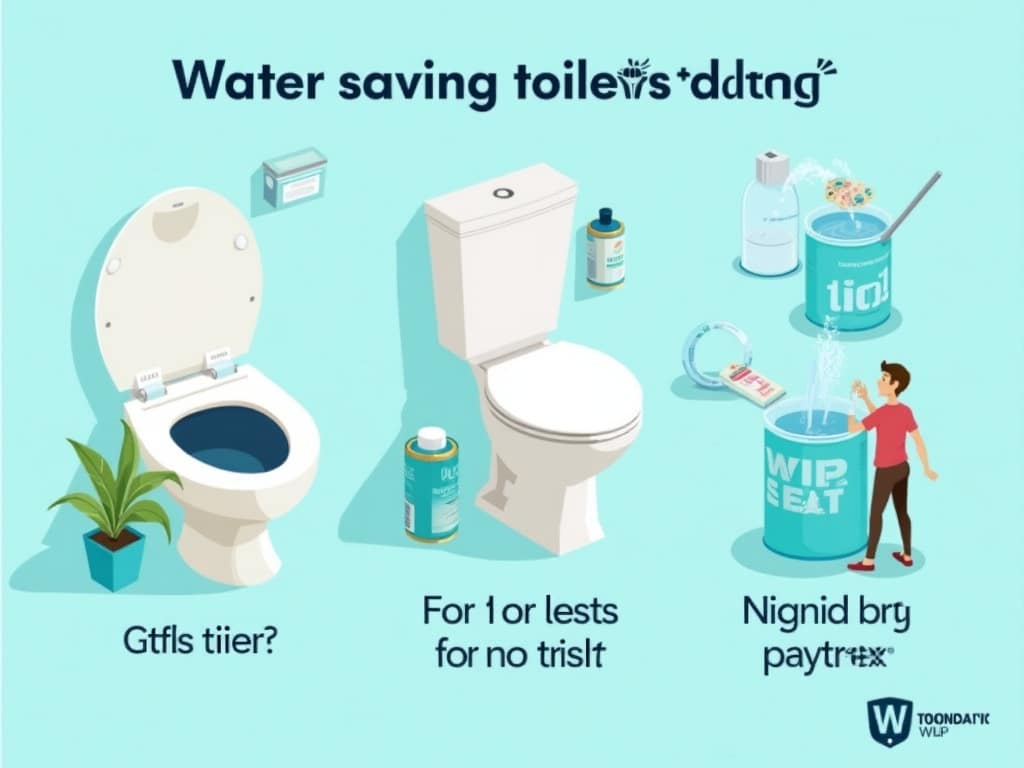Water-Saving Toilets: Weighing the Pros and Cons of a Water-Wise Choice
Imagine a world where every drop of water counts. Where conservation isn’t just a trend, but a necessity. In the realm of household water usage, toilets often take the crown as the biggest water guzzlers. But what if you could significantly reduce your water consumption with a simple switch? Enter water-saving toilets – modern marvels designed to flush away waste while using a fraction of the water of their older counterparts. But are they all they’re cracked up to be? Let’s dive into the fascinating world of water-saving toilets, exploring their benefits, drawbacks, and everything in between.
Understanding Water-Saving Toilets: A Modern Solution
Water-saving toilets, also known as low-flow or high-efficiency toilets (HETs), are designed to use significantly less water per flush than older, traditional models. The evolution of these toilets has been driven by increasing awareness of water scarcity and the need for sustainable living.
The WaterSense Program: Setting the Standard
The EPA’s WaterSense program plays a crucial role in identifying and promoting water-efficient products. Toilets that earn the WaterSense label must use no more than 1.28 gallons per flush (GPF), a significant reduction compared to the 3.5 GPF or more used by older toilets. This translates to substantial water savings over time.
Types of Water-Saving Toilets
**Single-flush Toilets:These toilets use a single flush mechanism with a pre-set amount of water (typically 1.28 GPF or less). They’re simple, reliable, and often the most affordable option.
**Dual-flush Toilets:Dual-flush toilets offer two flushing options: a partial flush for liquid waste (often around 0.8 GPF) and a full flush for solid waste (usually 1.28 GPF). This allows for even greater water savings.
**Pressure-assisted Toilets:These toilets use compressed air to create a powerful flushing action, often using 1.0 GPF or less. They are known for their effectiveness in clearing the bowl completely.
**Composting Toilets:These toilets don’t use water at all. Instead, they use natural decomposition processes to break down waste. They are ideal for off-grid living or environmentally conscious homeowners.
The Pros of Switching to a Water-Saving Toilet
The benefits of installing a water-saving toilet extend beyond mere water conservation. They touch on cost savings, environmental responsibility, and even enhanced performance in some cases.
Significant Water Savings and Lower Bills
This is the most obvious and compelling advantage. Replacing an old 3.5 GPF toilet with a WaterSense-certified 1.28 GPF model can save thousands of gallons of water per year. The EPA estimates that a family can save more than 13,000 gallons of water annually by replacing old, inefficient toilets with WaterSense models. This translates directly into lower water bills, putting money back in your pocket.
Environmental Responsibility: A Step Towards Sustainability
Conserving water is crucial for protecting our planet’s resources. Water-saving toilets help reduce the strain on local water supplies, minimize the energy needed to treat and distribute water, and decrease the amount of wastewater released into the environment. By choosing a water-saving toilet, you’re actively contributing to a more sustainable future.
Potential Rebates and Incentives
Many municipalities and water companies offer rebates and incentives for homeowners who install WaterSense-certified toilets. These programs are designed to encourage water conservation and can significantly offset the initial cost of upgrading your toilet. Check with your local water provider to see if any rebates are available in your area.
Improved Performance and Aesthetics
Modern water-saving toilets often incorporate innovative designs and technologies that improve flushing performance. Pressure-assisted models, for example, are known for their powerful flush that effectively removes waste. Additionally, many water-saving toilets boast sleek, contemporary designs that can enhance the look of your bathroom.

The Cons of Water-Saving Toilets: Addressing the Concerns
While the advantages of water-saving toilets are numerous, it’s essential to acknowledge the potential drawbacks. These can range from higher upfront costs to concerns about flushing power.
Higher Upfront Cost
Water-saving toilets typically have a higher initial cost compared to traditional, less efficient models. This can be a barrier for some homeowners, especially those on a tight budget. However, it’s important to consider the long-term cost savings from lower water bills, which can often offset the higher upfront investment over time. Be sure to shop around, compare prices from different retailers, and check for available rebates to minimize the financial impact.
Potential for Clogging
Some older models of low-flow toilets had a reputation for being prone to clogging. This was often due to insufficient water volume to effectively move solid waste through the drainpipe. However, modern water-saving toilets, particularly pressure-assisted and dual-flush models, have made significant improvements in flushing performance. To minimize the risk of clogging, choose a WaterSense-certified toilet and consider the diameter of your drainpipe. Older homes with narrower drainpipes may benefit from a pressure-assisted model.
Maintenance and Repair Considerations
While generally reliable, water-saving toilets may require occasional maintenance and repairs. Dual-flush mechanisms, for example, can sometimes be more complex to repair than single-flush systems. However, most common toilet repairs, such as replacing a flapper or fill valve, are relatively straightforward and can be done by a DIY enthusiast or a qualified plumber.
Noise Levels
Pressure-assisted toilets, while powerful, can be noisier than gravity-fed models. The sound of the compressed air being released during the flush can be noticeable, especially in smaller bathrooms or homes with thin walls. If noise is a major concern, consider a gravity-fed, dual-flush toilet instead.
Making the Right Choice: Factors to Consider
Choosing the right water-saving toilet for your home depends on several factors, including your budget, water usage habits, and personal preferences. Here’s a guide to help you make an informed decision:
Assess Your Water Usage
Take a look at your current water bill to get an idea of how much water you’re using. If you have older, inefficient toilets, you’re likely using a significant amount of water just flushing. Calculate your potential savings by comparing the GPF of your current toilets to the GPF of WaterSense-certified models.
Consider Your Budget
Water-saving toilets range in price from affordable to premium. Set a budget before you start shopping and stick to it. Remember to factor in potential rebates and long-term water savings when evaluating the overall cost.
Evaluate Flushing Performance
Read online reviews and talk to plumbers or other homeowners about their experiences with different types of water-saving toilets. Consider the size of your household and the potential for heavy usage when assessing flushing performance.
Check for WaterSense Certification
Always look for the WaterSense label when choosing a water-saving toilet. This ensures that the toilet meets EPA’s standards for water efficiency and performance.
Think About Aesthetics
Toilets come in a variety of styles and finishes. Choose a model that complements the look of your bathroom. Consider features like bowl shape, height, and color.
Installation and Maintenance Tips
Proper installation and maintenance are crucial for ensuring the long-term performance of your water-saving toilet.
Professional Installation vs. DIY
While it’s possible to install a toilet yourself, it’s often best to hire a qualified plumber, especially if you’re not experienced with plumbing work. A professional can ensure that the toilet is installed correctly and that all connections are tight, preventing leaks and other problems.
Regular Cleaning and Maintenance
Clean your toilet regularly with a non-abrasive cleaner to prevent mineral buildup and stains. Check the flapper valve and fill valve periodically to ensure they’re functioning properly. Replace worn parts promptly to prevent leaks and water waste.
Troubleshooting Common Problems
If your toilet is running constantly or flushing weakly, it could be due to a faulty flapper valve, fill valve, or flush mechanism. Consult a plumbing guide or call a plumber for assistance.
The Future of Water Conservation: Beyond Toilets
Water-saving toilets are just one piece of the puzzle when it comes to water conservation. There are many other ways to reduce your water footprint, both inside and outside the home.
Low-Flow Showerheads and Faucets
Install low-flow showerheads and faucets to reduce water consumption while showering and washing your hands.
Water-Efficient Appliances
Choose WaterSense-certified washing machines and dishwashers.
Landscaping with Native Plants
Use native plants in your landscaping, as they require less water than non-native species.
Rainwater Harvesting
Collect rainwater in barrels or cisterns for use in watering your garden or lawn.
Conclusion: Making a Splash with Water Conservation
Switching to a water-saving toilet is a simple yet powerful way to conserve water, save money, and contribute to a more sustainable future. While there are some potential drawbacks to consider, the benefits far outweigh the risks. By understanding the different types of water-saving toilets, evaluating your needs, and following proper installation and maintenance guidelines, you can make a smart choice that will benefit both your wallet and the planet. So, are you ready to make a splash with water conservation?
